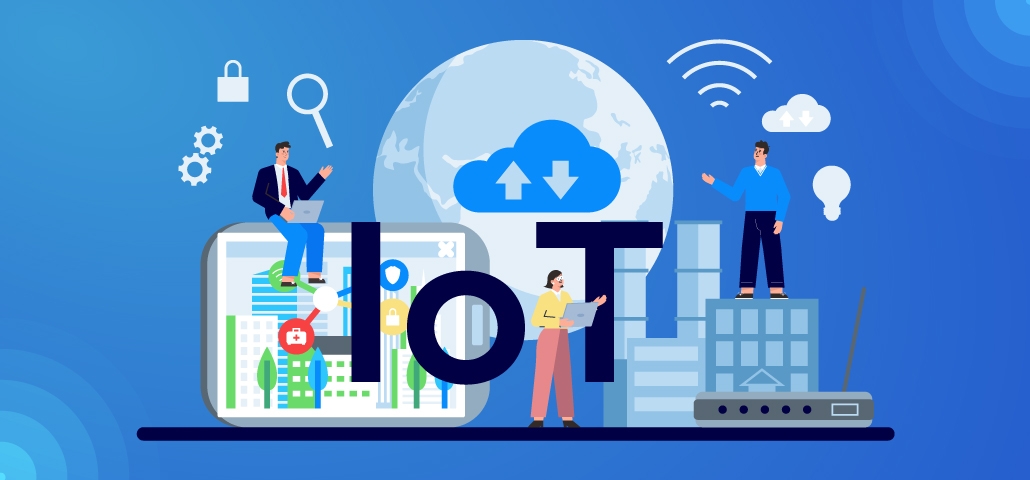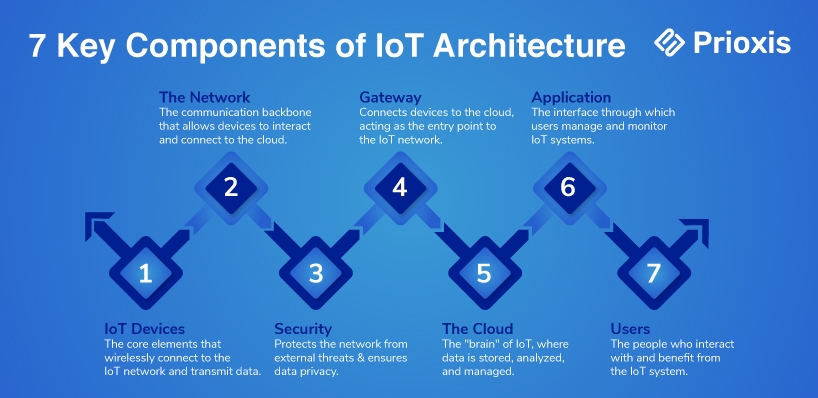
Table of Content
What once seemed like science fiction, the Internet of Things (IoT) has now become a reality, transforming industries through innovations like carsharing, fitness trackers, smart logistics, and autonomous warehouses. IoT offers significant advantages across various sectors, fundamentally altering how businesses operate.
In the age of connected devices, IoT architecture plays a vital role in how enterprises design and deploy IoT applications. This detailed guide will take you through the essential components and layers of Internet of Things architecture, offering a clear understanding of how these elements come together to support sophisticated IoT solutions.
The Internet of Things (IoT) combines the global Internet network with physical devices like sensors and smartphones. This connectivity enables devices to communicate and share data, forming an IoT system. Without this connection, the benefits of IoT are lost.
By early 2023, over 13 billion devices were connected worldwide—almost double the global human population.
IoT’s success relies on seven critical components:

Designing an Internet of Things (IoT) system requires a focused approach that addresses the distinct challenges of managing and connecting numerous devices. Traditional methods of data handling fall short in the context of IoT, where potentially thousands of devices are interconnected and communicating in real time.
IoT architect involves creating every aspect of an IoT system, from data management to user interfaces, with a focus on the unique demands of IoT solutions. It’s a multi-layered structure designed to ensure that the entire system operates efficiently and securely, from data collection to user interaction. This approach covers all elements of IoT architecture, ensuring efficient and scalable software solutions for enterprises.
The sensing layer is where it all begins. This layer is composed of sensors and actuators that interact with the physical world, gathering data from the environment. These sensors can detect everything from temperature changes to motion, providing the raw data that will drive the IoT system.
Includes various sensors like temperature, humidity, and motion detectors, as well as actuators like motors and valves.
To capture and relay environmental data, which serves as the input for the entire IoT architecture.
Sensors are the front-line components in an IoT system. They are responsible for detecting changes in the environment and converting these changes into data that can be processed by the system.
Actuators are devices that convert processed data into physical action. Unlike sensors, which gather data, actuators respond to the commands issued by the central processing unit.
The network layer is responsible for transporting the data collected by sensors to the processing units. This layer encompasses a range of communication technologies and protocols that ensure data flows smoothly between devices and the central system.
Routers, gateways, and communication protocols like MQTT and CoAP.
Purpose To enable secure and reliable data transmission across the IoT ecosystem.
Once data reaches the processing layer, it undergoes analysis and transformation to extract valuable information. This layer can handle everything from real-time data processing to complex analytics, depending on the system’s requirements.
IoT cloud architecture, edge computing solutions, and databases.
Purpose To analyze, filter, and store data for further use, ensuring that only relevant information is processed.
Components User interfaces like mobile apps, web dashboards, and control systems.
Purpose To provide a user-friendly interface for interacting with the IoT system and interpreting data.
Security in IoT architecture cannot be overstated. The security layer ensures that all data and communications within the IoT system are protected against unauthorized access, breaches, and cyber threats.
Components Encryption tools, firewalls, and identity management systems.
Purpose To protect data integrity and ensure secure communication throughout the IoT architecture.
Middleware is the unsung hero of IoT architecture, facilitating the seamless connection between various components and ensuring that they work together harmoniously. It manages the data flow between the layers and allows for integration with third-party services.
Components APIs, integration platforms, and middleware solutions.
Purpose To enable communication between different IoT devices and systems, ensuring interoperability.
Read More: Explore the use cases and benefits of IoT in healthcare.
When designing an IoT system, several principles must be adhered to ensure the system is effective, secure, and scalable. These considerations are critical for the long-term success of IoT applications, especially in an enterprise setting.
User-centered design focuses on creating IoT systems that are intuitive and easy to use. This approach requires understanding the needs and behaviors of the end-users, ensuring that the technology serves them effectively. Designing a smart thermostat that allows users to easily set preferences and schedules through a simple interface, either via mobile app or voice commands.
As IoT deployments grow, the architecture must be able to scale to handle increased data loads, more devices, and more complex applications. Scalability ensures that the system remains efficient and responsive even as demands increase. Using cloud-native services that automatically scale resources based on demand helps maintain performance as the system expands.
Interoperability refers to the ability of different IoT devices and systems to work together seamlessly, even if they are from different manufacturers. This is critical in creating a cohesive IoT ecosystem. Ensuring that smart home devices from various brands can communicate and be controlled through a single platform.
Handling the vast amounts of data generated by IoT devices requires robust data management strategies. Ensuring that data is collected, stored, and processed securely is crucial to maintaining user trust and meeting regulatory requirements. By implementing data encryption, both in transit and at rest and ensuring compliance with regulations like GDPR or CCPA.
IoT devices often run on batteries or have limited power supplies, making energy efficiency a key consideration in their design. Efficient power usage extends the life of devices and reduces operational costs. Developing low-power communication protocols and optimizing sensor data collection intervals to minimize energy consumption.
Before full-scale deployment, prototyping and testing are essential steps in IoT application development. This phase allows designers to validate the functionality, usability, and reliability of the IoT system in a controlled environment. Conducting thorough testing in real-world conditions to ensure the system performs as expected under various scenarios.
Once the IoT system is designed and tested, the deployment phase involves rolling out the system across the target environment. Ongoing maintenance is essential to ensure the system continues to operate efficiently, including regular updates, monitoring, and troubleshooting. Setting up automated monitoring systems that alert administrators to potential issues, ensuring timely maintenance and reducing downtime.
As enterprises grow, so do their IoT needs. Scalability is a critical factor in IoT architecture, allowing systems to handle increased data loads and integrate new technologies like AI and machine learning for enhanced functionality. Modular designs, cloud-native architectures, and AI integration.
Future Trends Adoption of edge computing, AI-driven IoT solutions, and the implementation of 5G networks.
Modular Designs Modular designs allow IoT systems to expand and adapt over time. By designing systems in modules, enterprises can add new devices or features without disrupting the entire system.
Example: A modular smart home system might allow users to start with basic security features and gradually add lighting control, climate management, and energy monitoring.
Cloud-Native Architectures Cloud-native architectures are built to take full advantage of cloud environments, offering scalability, flexibility, and resilience. These architectures are essential for managing the large-scale deployments typical in enterprise IoT.
Example: A cloud-native IoT platform might automatically scale resources up or down based on the number of connected devices and data traffic.
AI Integration Integrating AI with IoT systems can enhance the decision-making process by analyzing data patterns and predicting outcomes. This is especially useful in predictive maintenance, smart cities, and other complex IoT applications.
Example: An AI-powered predictive maintenance system might analyze data from industrial sensors to predict equipment failures before they occur, reducing downtime and maintenance costs.
For enterprises, understanding and implementing the right IoT architecture is crucial for creating systems that are not only effective but also secure and scalable. A well-thought-out IoT architecture ensures that all components—from sensors to applications—work together seamlessly, providing real-time data and insights that drive business decisions.
This guide has explored the key layers of IoT architecture, each playing a crucial role in the overall functionality of IoT applications. By focusing on the design and implementation of these layers, enterprises can develop IoT solutions that meet their specific needs, ensuring that they remain competitive in a rapidly advancing technological landscape.
Investing in a robust IoT architecture is not just about keeping up with the latest trends; it’s about building a foundation for future innovation and growth. Whether you’re developing new IoT solutions or optimizing existing ones, a deep understanding of IoT architecture will be instrumental in achieving long-term success.
Get in touch